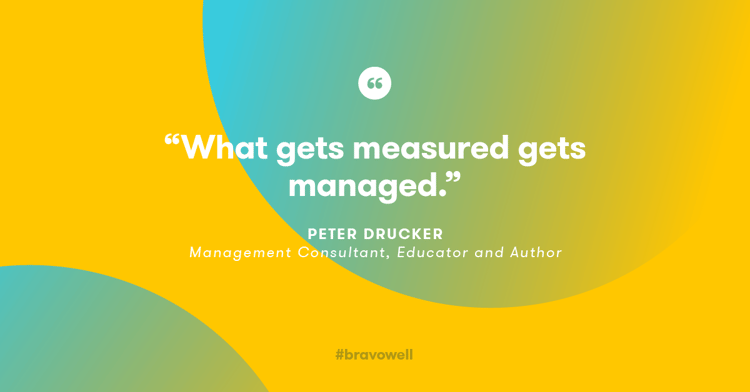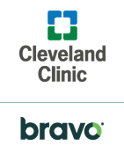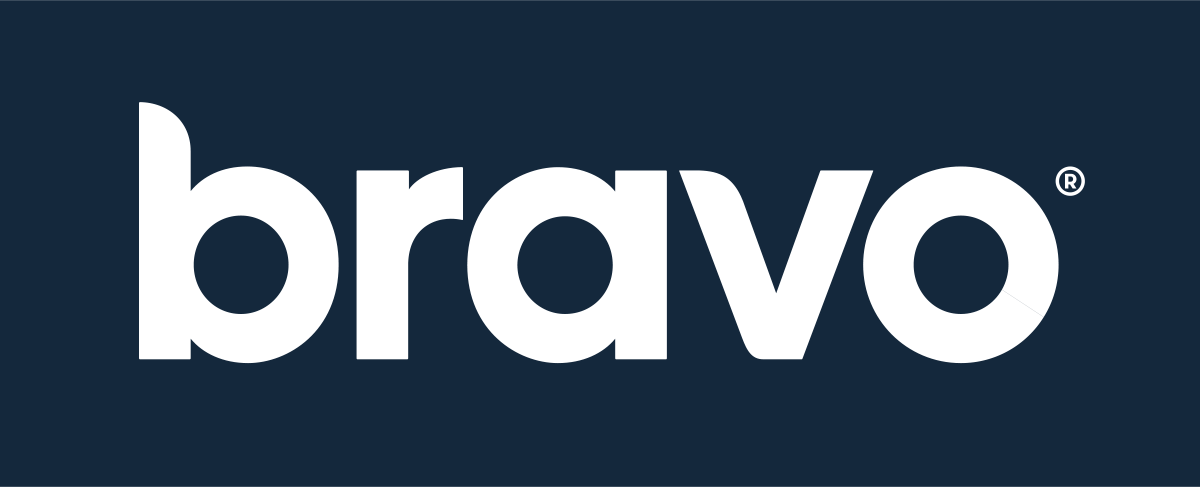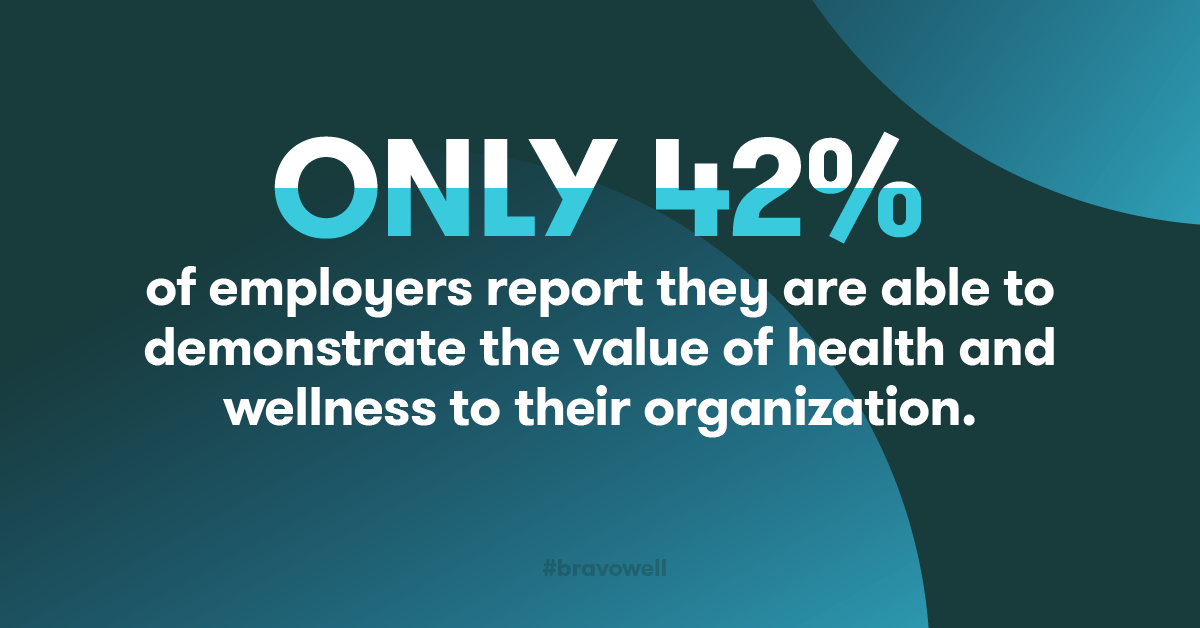On the outside, the appeal of employee wellness programs is often synonymous with a true wow factor. After reading a program’s description of expected outcomes, it’s easy for an HR professional or organizational leader to think, “Wow! Impressive. This program can help our organization move mountains.”

Our quick rebuttal to this is perhaps. No employee wellness program is magic without proper individualization and continuous evaluation.
It’s never enough to simply launch a program and let it be. Any high performing company must focus on achieving its wellness program vision by accurately measuring its progress and adjusting along the way.
Results and ROI should never be far from thought. You must be highly focused on program outcomes to:
- Identify accomplishments
- Justify the program’s existence
- Ensure the organization’s time, resources and budget are spent in meaningful ways
- Achieve true employee health and wellness betterment
The WHAT and the HOW of Wellness Program Metrics
Peter Drucker—consultant, author, and educator known as the founder of modern management—was right when he wrote “What gets measured gets managed.” However, this statement doesn't mean that what can't be measured isn't worth managing.
In any area of your business, it's important to not only think about what you measure to gauge performance, but also, and more importantly, the how.
A Quick Look at Leading and Lagging Indicators of Performance
In performance management, the terms “lagging and leading indicators” are often tossed around.
- Lagging indicators: output oriented, easy to measure, hard to improve or influence
Example: In a weight loss journey, you step on a scale to see if you’ve lost weight. This is very easy to measure.
- Leading indicators: input oriented, hard to measure, easy to improve or influence
Example: In the same weight loss journey, in order to actually lose the weight, you have to count calories consumed and calories burned. For the average individual, this can prove to be a very hard task and, therefore, very hard to measure (with eating out, busy schedules, and a lack of a precise calorie counting tool).
In business, activities of the company – such as revenue, profit and costs – are typically lagging indicators (easy to measure). Activities or attributes undertaken by employees – such as morale, loyalty, quality of work life, wellness initiatives, and others – are typically leading indicators (hard to measure).
It’s important to note that lagging indicators are not negative gauges. They’re simply influenced by the leading indicators.
Nevertheless, proving the impact of your worksite wellness program is possible.
Whether you consider your wellness program to be successful or a work in progress, it's no secret that it’s difficult to measure its full impact on your people.
Why? Mainly because when it comes to a person's health, there are so many factors at play – such as socioeconomic status, home and family life, genetics, work environment, and much more. However, that doesn't mean you have to give up trying to measure the impact or jump to the conclusion that it doesn't have an impact at all.
Only 42% of employers report they are able to demonstrate the value of health and wellness to their organization. A third of employers say they have the metrics they need to justify their investment in a health and wellness program.1
How to Calculate ROI for Employee Wellness Programs: 3 Steps to Creating the Right Metrics
Step One: Start With Why.
Every wellness program needs a clear vision. Why is your organization on this wellness journey? What are you trying to achieve?
The most common reasons employers invest in employee wellness:
- Reduce employee health risks
- Reduce healthcare costs
- Improve employee productivity1
All of those reasons may be important to you, but are they equally important? According to a study conducted by Optum – a leading health services innovation company – the health risk reduction and healthcare cost savings associated with certain configurable employee wellness programs are actually 40% more important to employers than productivity improvements.1
Defining your why is the defining step. Ultimately, your why should be anchored to what your organization stands for and why it’s worth it to implement and engage in a wellness program.
Step Two: Select Your Metrics.
Once you have your why, you’ll want to select the metrics you want to track based on the what the program was designed to achieve.
For example, if your goal is retention, you need to understand what is currently driving retention. Think: What do employees value (or don't) that makes them more loyal?
You need to be specific. It's not as straightforward as saying that you need to improve employee “engagement” to have better retention.
Stay with us on this train of thought: Do employees appreciate their benefits and compensation the most? If that's the key to retention, it should be the focus of your wellness program. If they want better job satisfaction and career development, then that should be your focus.
To help you center your thoughts and further your strategy on step two, read our post the benefits that are most important to employees: Benefits that Employees Value the Most.
Step Three: Analyze Your Data.
It’s important to analyze the data in terms of operational performance and outcomes.
When it comes to analyzing the operational performance (leading indicators) of your wellness program, smart questions to ask are:
- How many people have signed up for activities that are part of the program like a screening, lunch and learn, or coaching?
- What are employees engaging with most frequently?
- What do they not engage with?
Example: If one of your goals is to reduce ER utilization:
- What did you do in your program to discourage this method of care?
- Did you encourage the population to establish a primary care provider relationship?
- How many people met with their primary care physician during the year?
When it comes to analyzing your wellness program outcomes (lagging indicators), smart questions to ask are:
- Did people engage in interventions, and if so, were those people the ones who needed them?
- Did the people who engaged in interventions in year one have changes in their health status in year two?
- Of your cohort population, are people reducing health risks or gaining them?
- Did wellness program participants generate less in healthcare claims in preventable categories than non-participants?
- What impact do spouses have on overall healthcare spend? Are spouses engaging in the program, or does more need to be done to engage them?
Data Challenges Don’t Have to Be a Permanent Roadblock
As an HR professional, it’s expected that certain metrics live outside of your day-to-day realm and professional training. HIPAA compliance and not seeing individual employee data may also be a challenge for you within your organization.
As individuals who also understand the HR role very well, we know firsthand that without training in research methodology and analytics, it is difficult to gain actionable insights on all we’ve discussed above.
But without expertise in how to improve specific areas of the business that are underperforming, how can you improve?
Measure and Encourage Progress Within Your Employee Population With Crystal Clear Data from Bravo
A lot of wellness programs use claims analysis to influence their wellness program design so that they can stratify wellness participants and direct them to interventions for high-risk individuals.
We don't disagree with this methodology, but wouldn't you want to be able to make an impact in employees’ lives more proactively?
Our configurable wellness programs are centered around creating and sustaining motivation to help employees get and stay healthy. By collecting and delivering crystal clear reporting of aggregated claims and biometric data, we can show you pockets of the population that need extra attention, but also those who report a high readiness to change, so that together, we can improve the health of your workforce in a targeted and meaningful way.
For example: After reviewing their wellness program report from Bravo, Graco Inc. was able to respond proactively to a high prevalence of elevated blood sugar levels within their population. Now, instead of covering nutrition counseling for the diabetics on their medical plan, they offer nutrition counseling at 100% coverage for all of their employees. To learn more about Graco’s wellness journey, watch our recorded webinar: How Graco Inc. Created a Nationally-Recognized Wellness Program.
By partnering with Bravo on your wellness initiatives, you don't just get data. You get the analysis and insights that can help you improve your organization's action plan for wellness and well-being.
Improve Employee Wellness & Double Down on Rising Healthcare Costs
Historically, healthcare hasn't done a great job of promoting disease prevention. That's why Cleveland Clinic Wellness was created in 2007 with the goal of focusing on "health care, not just sick care."
Cleveland Clinic and Bravo have now joined forces to double down on the employer healthcare cost crisis, specifically to target and address prevention and lifestyle management before habits become health risks, and before health risks become chronic health issues.
With evidence-based interventions and a strategic wellness program designed to improve the health and well-being of your employees, your organization and employees will thrive.
 Through this new offering, we’re paving the way towards stronger, sustainable employee benefits. Learn more about the new Cleveland Clinic | Bravo program by watching our webinar that explains all the elements that make up a new clinical standard for employee wellness.
Through this new offering, we’re paving the way towards stronger, sustainable employee benefits. Learn more about the new Cleveland Clinic | Bravo program by watching our webinar that explains all the elements that make up a new clinical standard for employee wellness.
Resources:
1 Optum. Beyond ROI: Building employee health & wellness value of investment. Accessed May 15, 2019. https://www.optum.com/content/dam/optum/resources/whitePapers/Beyond_ROI_health-wellness-investment.pdf.


